8 Popular Single Line Kite Design | Kite Club India | Kite Flyers India
Types Of Kites8 Popular Single Liners
We build and fly many different types of kites that are known in the West, as you probably know by now. Not all of them originated in the West though...
For example, our Dowel Sode over there on the left has a sail shape that copies the Japanese Sode Dako.
On this page, the focus is definitely on single-liners, and 'flat' types of kites in particular.
However, I like to include designs with bowed spars or dihedral in the 'flat' category. Not to mention Deltas, despite the small amount of billow in their sails which helps to keep them stable.
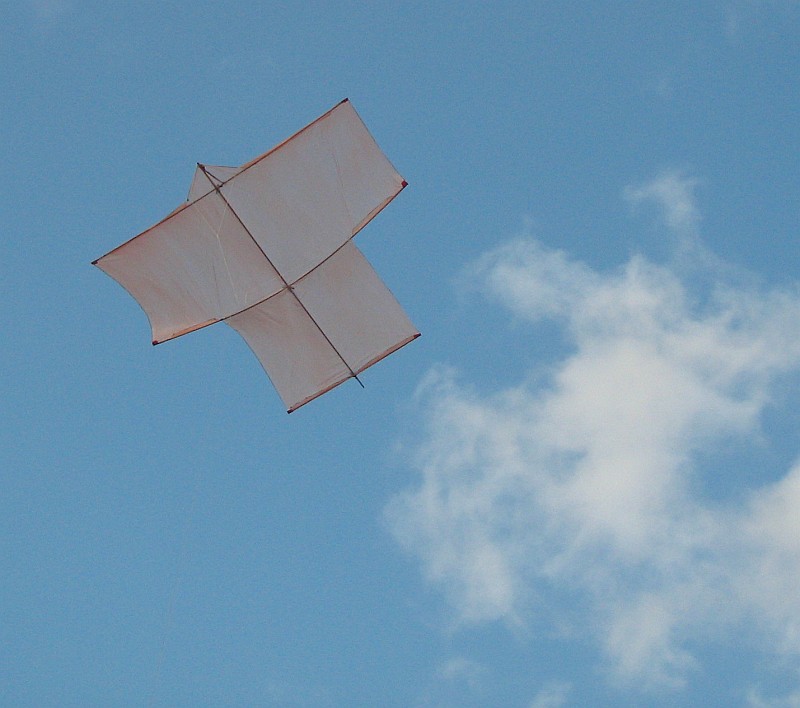
A couple of these types, the Diamond and the Delta, are almost 'household names' now. Particularly during April in the USA, when it is officially 'kite month' over there! Even in China, where kites have been popular for many centuries, the Diamond and Delta from the West are catching on and being absorbed into the local kite culture.
Apart from those 2 types, we hope you enjoy getting educated about some others that are not quite as well known...
The Sled Kite
A ram-airl Sled kite in flight.
In terms of popularity and sheer numbers, the Sled kite is up there in the Big Three - Sleds, Diamonds and Deltas.
I've never seen a truly large Sled of the 2-stick variety, but have often seen smaller ones flying here and there. Usually with inflatable spars, as in the photo. In parks, down at the beach, even at Kite Festivals.
This entire web site started out by featuring a humble little $5 all-plastic Sled we bought for our toddler! It's still out there in the back shed...
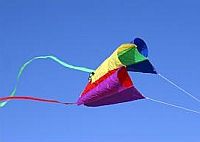
A bit of research on these types of kites turned up an amazing variety of configurations for such a seemingly simple design. Extra spars, vents, cutouts, you name it. Whatever its exact form, the attractive thing about these kites is the built-in transportability and instant setup. Pure convenience.
The flying performance of store-bought Sled kites tends to be modest, but that doesn't bother the people who fly them!
The Diamond Kite
I can't help noticing how often we are bombarded with images of the Diamond kite in daily life. These types of kites are everywhere.
It seems every second kid's show on T.V. and every second children's book has an image or 3 of this extremely well-known kite shape. It seems that, in the West at least, the word 'kite' is almost synonymous with the shape 'diamond'.
Hear 'kite', see a 'diamond'!
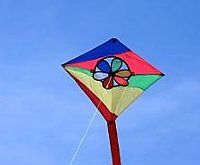
As a family we have often seen a Diamond kite of some description floating on the breeze. Usually, the person taking an opportunity to fly a kite is hidden by the houses and trees of suburbia here in Adelaide.
Interestingly, all our building and flying of simple Diamonds has underscored the basic reliability and idiot-proof nature of these types of kites! Many other designs can have their quirks and give trouble when built from scratch by inexperienced fliers. No wonder the Diamond is so popular. The larger ones which break down for transport are very quick to set up too.
With accurately made modern materials, Diamond kites can have quite a good wind range, although they don't necessarily fly at very steep line angles.
In some corners of the world, you might hear a Diamond referred to as an Eddy kite. There are a number of similarities!
The Barn Door Kite
With so many visitors from the U.S. passing through this site, it's appropriate to include a design that apparently originated in that country. The 3-spar Barn Door doesn't make it into my top 3 types of kites. However, a little browsing around the Web reveals that a number of keen kite people take pride in making and flying large examples of these types of kites.
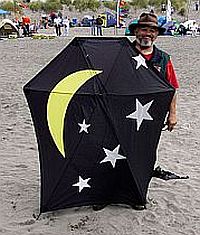
I have to admit, I've never seen a Barn Door flying here in Australia! Apart from our own MBK versions of course. There must be a few around though, since the term '3-sticker' has been in use for many years.
Both our own Skewer designs are very much at home in fresh breezes, although we fly them both with tails. Larger Barn Door kites are able to fly tail-less, at least in light to moderate winds.
The Rokkaku Kite
The Rokkaku kite, often abbreviated to just 'Rok', has to be the most copied Japanese kite in the West.
These types of kites are everywhere, from small ones turned out from children's kite-making workshops right through to large expensive air-brushed versions for sale in kite shops. There's always a few big Roks floating around at our local kite festival each year.
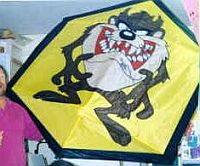
Like the Diamond and Delta, flying characteristics have a lot to do with their considerable popularity! In my humble opinion. However, they don't quite make the Big Three.
I've seen a Rok Battle at a kite festival, and have to say it's not a bad spectator sport! The competitors try to force all the other kites to the ground, any way they can. Well, not quite, I'm sure firearms would be against the rules ;-) Personally, I'm not so much into kite fighting, and prefer to fly my Rokkakus up to 400 feet in light wind and thermal conditions.
Rokkaku kites are quite forgiving to construct and fly. They are so stable that a tail is needed only for decoration, or perhaps in strong wind conditions. The larger Roks can have more bow pulled into the lower spar for more stability anyway.
The Sode Kite
The Delta Kite
Our old Windjam Delta kite.
Number 3 of The Big Three! Of all the different types of kites, the Delta kite is most commonly recommended to beginners by shops and festival commentators, for good reason.
The Delta is easy to launch, flies on the lightest of breezes, and almost always sits at a good steep line angle. These characteristics have pushed along the popularity of this design to huge levels, despite having only a fraction of the history of the Diamond and perhaps even the Sled kite.
The vast majority of Delta kites are bought from a shop, since they are not nearly as straight-forward to construct as the Diamond or Sled. However, building Delta kites can be very rewarding, as I can attest!
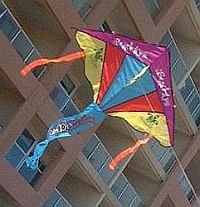
Our experience of Deltas has uncovered a tendency for them to get unpredictable in gusty or fresh winds. However, in light winds or stronger smooth breezes they are truly wonderful fliers.
Dan Leigh has been designing light wind kites since 1974, and specializes in the Delta configuration. Customers rave about the quality and performance of Dan's Delta kites. Mind you, they don't come cheap!
The Roller Kite
An attractive home-made Roller kite.
Not a super-popular design now, but there are people out there who really love their Rollers!
An efficient light wind kite that can be adjusted for flying in stronger winds, the Roller has its roots in pre-War Germany.
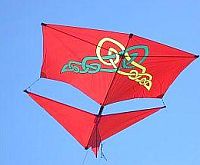
With its tail-less design and steep flying angles, this kite is handy for flying in confined areas.
Our MBK Rollers are reliable fliers, based on the Pearson Roller, with the 2-Skewer one quite capable of going overhead on 90 meters (300 feet) of line. Despite its very modest size. The even smaller 1-Skewer design once caught the eye of a German blogger who marveled at how a Roller could be so cheap!
I have a sneaking suspicion that Roller kites are more liked and well known in Germany and other parts of Europe than elsewhere on the planet. After all, that's where the basic concept originated.
The Dopero Kite
A Dopero kite, from Scotland.
Hardly a common kite, the Dopero is however much appreciated with the Kite Aerial Photography crowd. This design is capable of hoisting camera gear aloft in light winds better than other designs of similar sail area.
The original kite was actually inspired by the idea of overlapping 2 Pearson Rollers. Hence DOuble PEarson ROller or 'Dopero'.
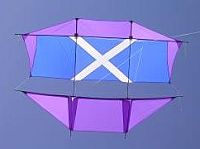
Our Doperos are rather loosely based on the original! These types of kites generally have drag-pockets under the trailing edge, but ours have twin keels. Also, ours have much lower aspect ratios. To put that in entirely non-technical language, ours are 'stumpy' compared to the more 'graceful' types of kites that were originally made. I have my reasons for this, and it doesn't stop the 2-Skewer version going directly overhead on 120 meters (400 feet) of line...
The very best shop-bought Dopero kites are wonderful hi-tech pieces of gear. Hence they are expensive, with dollar prices in 3 digits!
National Kite Festival Events
International Kite Festival Events
Kite Flying Competition Kite Flying Training for Students.
Kite Flying for Individual Private Marriage Functions, Corporate Events, School Competition and Special Occasions.
Kite Fighting Competition
Kite Making Competition
Inter School Kite Competition
Kite Painting
Kite Exhibition and Knowledge Programm
kite club india
Kite Flyers India
We build and fly many different types of kites that are known in the West, as you probably know by now. Not all of them originated in the West though...
For example, our Dowel Sode over there on the left has a sail shape that copies the Japanese Sode Dako.
On this page, the focus is definitely on single-liners, and 'flat' types of kites in particular.
However, I like to include designs with bowed spars or dihedral in the 'flat' category. Not to mention Deltas, despite the small amount of billow in their sails which helps to keep them stable.

A couple of these types, the Diamond and the Delta, are almost 'household names' now. Particularly during April in the USA, when it is officially 'kite month' over there! Even in China, where kites have been popular for many centuries, the Diamond and Delta from the West are catching on and being absorbed into the local kite culture.
Apart from those 2 types, we hope you enjoy getting educated about some others that are not quite as well known...
The Sled Kite
A ram-airl Sled kite in flight.
In terms of popularity and sheer numbers, the Sled kite is up there in the Big Three - Sleds, Diamonds and Deltas.
I've never seen a truly large Sled of the 2-stick variety, but have often seen smaller ones flying here and there. Usually with inflatable spars, as in the photo. In parks, down at the beach, even at Kite Festivals.
This entire web site started out by featuring a humble little $5 all-plastic Sled we bought for our toddler! It's still out there in the back shed...

A bit of research on these types of kites turned up an amazing variety of configurations for such a seemingly simple design. Extra spars, vents, cutouts, you name it. Whatever its exact form, the attractive thing about these kites is the built-in transportability and instant setup. Pure convenience.
The flying performance of store-bought Sled kites tends to be modest, but that doesn't bother the people who fly them!
The Diamond Kite
I can't help noticing how often we are bombarded with images of the Diamond kite in daily life. These types of kites are everywhere.
It seems every second kid's show on T.V. and every second children's book has an image or 3 of this extremely well-known kite shape. It seems that, in the West at least, the word 'kite' is almost synonymous with the shape 'diamond'.
Hear 'kite', see a 'diamond'!

As a family we have often seen a Diamond kite of some description floating on the breeze. Usually, the person taking an opportunity to fly a kite is hidden by the houses and trees of suburbia here in Adelaide.
Interestingly, all our building and flying of simple Diamonds has underscored the basic reliability and idiot-proof nature of these types of kites! Many other designs can have their quirks and give trouble when built from scratch by inexperienced fliers. No wonder the Diamond is so popular. The larger ones which break down for transport are very quick to set up too.
With accurately made modern materials, Diamond kites can have quite a good wind range, although they don't necessarily fly at very steep line angles.
In some corners of the world, you might hear a Diamond referred to as an Eddy kite. There are a number of similarities!
The Barn Door Kite
With so many visitors from the U.S. passing through this site, it's appropriate to include a design that apparently originated in that country. The 3-spar Barn Door doesn't make it into my top 3 types of kites. However, a little browsing around the Web reveals that a number of keen kite people take pride in making and flying large examples of these types of kites.

I have to admit, I've never seen a Barn Door flying here in Australia! Apart from our own MBK versions of course. There must be a few around though, since the term '3-sticker' has been in use for many years.
Both our own Skewer designs are very much at home in fresh breezes, although we fly them both with tails. Larger Barn Door kites are able to fly tail-less, at least in light to moderate winds.
The Rokkaku Kite
The Rokkaku kite, often abbreviated to just 'Rok', has to be the most copied Japanese kite in the West.
These types of kites are everywhere, from small ones turned out from children's kite-making workshops right through to large expensive air-brushed versions for sale in kite shops. There's always a few big Roks floating around at our local kite festival each year.

Like the Diamond and Delta, flying characteristics have a lot to do with their considerable popularity! In my humble opinion. However, they don't quite make the Big Three.
I've seen a Rok Battle at a kite festival, and have to say it's not a bad spectator sport! The competitors try to force all the other kites to the ground, any way they can. Well, not quite, I'm sure firearms would be against the rules ;-) Personally, I'm not so much into kite fighting, and prefer to fly my Rokkakus up to 400 feet in light wind and thermal conditions.
Rokkaku kites are quite forgiving to construct and fly. They are so stable that a tail is needed only for decoration, or perhaps in strong wind conditions. The larger Roks can have more bow pulled into the lower spar for more stability anyway.
The Sode Kite
The Delta Kite
Our old Windjam Delta kite.
Number 3 of The Big Three! Of all the different types of kites, the Delta kite is most commonly recommended to beginners by shops and festival commentators, for good reason.
The Delta is easy to launch, flies on the lightest of breezes, and almost always sits at a good steep line angle. These characteristics have pushed along the popularity of this design to huge levels, despite having only a fraction of the history of the Diamond and perhaps even the Sled kite.
The vast majority of Delta kites are bought from a shop, since they are not nearly as straight-forward to construct as the Diamond or Sled. However, building Delta kites can be very rewarding, as I can attest!

Our experience of Deltas has uncovered a tendency for them to get unpredictable in gusty or fresh winds. However, in light winds or stronger smooth breezes they are truly wonderful fliers.
Dan Leigh has been designing light wind kites since 1974, and specializes in the Delta configuration. Customers rave about the quality and performance of Dan's Delta kites. Mind you, they don't come cheap!
The Roller Kite
An attractive home-made Roller kite.
Not a super-popular design now, but there are people out there who really love their Rollers!
An efficient light wind kite that can be adjusted for flying in stronger winds, the Roller has its roots in pre-War Germany.

With its tail-less design and steep flying angles, this kite is handy for flying in confined areas.
Our MBK Rollers are reliable fliers, based on the Pearson Roller, with the 2-Skewer one quite capable of going overhead on 90 meters (300 feet) of line. Despite its very modest size. The even smaller 1-Skewer design once caught the eye of a German blogger who marveled at how a Roller could be so cheap!
I have a sneaking suspicion that Roller kites are more liked and well known in Germany and other parts of Europe than elsewhere on the planet. After all, that's where the basic concept originated.
The Dopero Kite
A Dopero kite, from Scotland.
Hardly a common kite, the Dopero is however much appreciated with the Kite Aerial Photography crowd. This design is capable of hoisting camera gear aloft in light winds better than other designs of similar sail area.
The original kite was actually inspired by the idea of overlapping 2 Pearson Rollers. Hence DOuble PEarson ROller or 'Dopero'.

Our Doperos are rather loosely based on the original! These types of kites generally have drag-pockets under the trailing edge, but ours have twin keels. Also, ours have much lower aspect ratios. To put that in entirely non-technical language, ours are 'stumpy' compared to the more 'graceful' types of kites that were originally made. I have my reasons for this, and it doesn't stop the 2-Skewer version going directly overhead on 120 meters (400 feet) of line...
The very best shop-bought Dopero kites are wonderful hi-tech pieces of gear. Hence they are expensive, with dollar prices in 3 digits!
National Kite Festival Events
International Kite Festival Events
Kite Flying Competition Kite Flying Training for Students.
Kite Flying for Individual Private Marriage Functions, Corporate Events, School Competition and Special Occasions.
Kite Fighting Competition
Kite Making Competition
Inter School Kite Competition
Kite Painting
Kite Exhibition and Knowledge Programm
kite club india
Kite Flyers India
Branding and Advertising With Kites
Please contact me on vibrantkiteclub@gmail.com with details.http://vibrantkiteclub.com/
Please contact me on vibrantkiteclub@gmail.com with details.http://vibrantkiteclub.com/
http://www.kiteclubindia.in91-9898194208
Source By : - http://www.my-best-kite.com/types-of-kites.html
Source By : - http://www.my-best-kite.com/types-of-kites.html














0 comments: